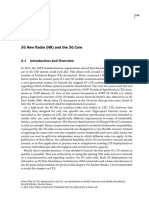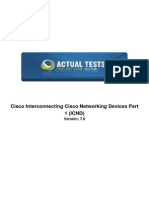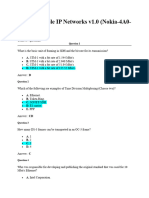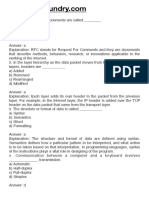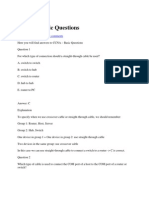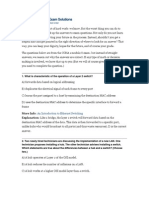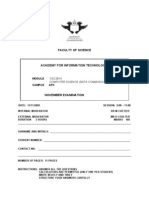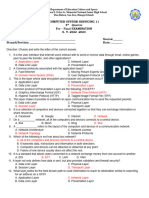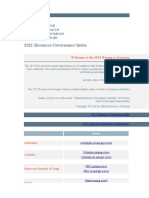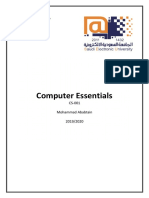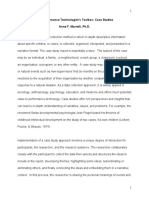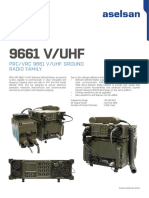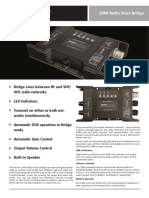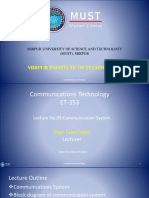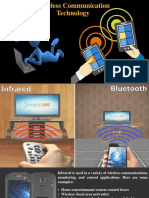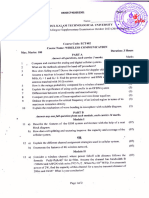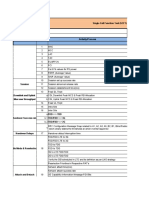Sample Quiz4
Sample Quiz4
Uploaded by
safCopyright:
Available Formats
Sample Quiz4
Sample Quiz4
Uploaded by
safOriginal Description:
Original Title
Copyright
Available Formats
Share this document
Did you find this document useful?
Is this content inappropriate?
Copyright:
Available Formats
Sample Quiz4
Sample Quiz4
Uploaded by
safCopyright:
Available Formats
Name _____________________________
QUIZ 4
CECS 474 Computer Network Interoperability
October 2012
Circle T or F for each of the following true or false questions (2 points each):
1. T or F The IEEE 802.3 protocol is the most widely used wireless LAN standard.
2. T or F The Hidden Node problem in WIFI networks occurs when not all stations can hear all
transmissions.
3. T or F The IEEE 802.11 protocol was originally designed to operate over three different types of
physical media.
4. T or F If the Exposed Node problem is solved, the throughput of an ad hoc wireless network may
increase.
5. T or F In CSMA/CA some kinds of collisions are possible; but collisions of data packets can not
occur.
6. T or F If your IEEE 802.11 enabled laptop boots and initiates contact with nearby access points, it is
using passive scanning.
7. T or F The format of IEEE 802.11 frames includes four address fields.
8. T or F WiMax is proposed as backhaul network and a an alternative to local access networks.
9. T or F In cell networks, perfect cell coverage occurs if each cell in a wireless network is a square.
10. T or F The latest generation of Cellular Technologies to be deployed is 4G.
11. T or F Bluetooth can be used to create a Personal Area Network (PAN).
12. T or F Spread Spectrum is used in IEEE 802.11 Wireless networks to help prevent electromagnetic
interference from other devices from affecting transmissions.
13. T or F Nyquist’s Sampling Theorem says that, when sampling an analog signal, the sample rate must
be at least three times as fast as the highest frequency.
14. T or F In “lossy” data compression, all information is retained in the compressed version.
15. T or F JPEG data compression uses “lossy” compression.
Select the best answer for the following multiple choice question (2 points):
16. Recall the reservation process of the 802.11 CSMA/CA protocol. Select the letter that corresponds to the
proper order of the commands that are sent back and forth from computer to basestation assuming no
errors:
(a) RTS -> CTS -> DATA-> CTS.
(b) CTS -> RTS -> DATA-> ACK.
(c) RTS -> CTS -> DATA-> ACK.
(d) TS -> CTS -> DATA-> CTS.
(e) CTS -> RTS -> DATA-> CTS.
Dr. Tracy Bradley Maples (Fall 2012)
(f) None of the above.
Dr. Tracy Bradley Maples (Fall 2012)
2
Given the following diagram showing five computers using WIFI IEEE 802.11 and each computers
transmission range, answer questions 17-21. (2 points each)
17.If A computer E
B C
D
__________- _________
18. If computer D transmits a message which computers will hear it? ___________________
19. If computer D hears a RTS but not the corresponding CTS, computer D is
free to initiate a transmission with another computer. True or False
20. If computer A hears a CTS but not the corresponding RTS, computer A is
free to initiate a transmission with another computer. True or False
21. It is possible for computer B to be transmitting to computer A at the
same time that computer C is transmitting to computer D. True or False
Given the following diagrams showing two WIFI IEEE 802.11 LANs, answer questions 22-25.
(2 points each)
A. B.
22. Is network A an ad hoc or an infrastructure network? ___________________________
23. Is network B an ad hoc or an infrastructure network? ___________________________
24. If Computer 1 transmits to Computer 2 in network A, how many separate times will the data need to be
transmitted? ______
25. If Computer 1 transmits to Computer 12 in network B, how many separate times will the data need to be
transmitted? ______
Dr. Tracy Bradley Maples (Fall 2012)
3
Identify the following terms with the phrase that most fully describes them.
Use each phrase only once. (2 points each)
26. ____ GEO Disadvantage A. Highest quality form of optical fiber.
27. ____ noise B. Unshielded Twisted Pair “extended” for noise immunity.
28. ____ UTP C. Random unwanted electromagnetic radiation.
29. ____20,000 miles D. Used for cable TV.
30. ____ guided media E. Low quality form of optical fiber.
31. ____ CAT-5e F. Communication follows an exact path.
32. ____ Coaxial Cable G. Appears fixed in space from a point on Earth’s
33. ____ mono-mode optical fiber H. Unshielded Twisted Pair usually used primarily for 10/100 Ethernets.
34. ____~ 90 minutes I. Ground stations must track the satellite.
35. ____ LEO Advantage J. Distance to be in geosynchronous Earth orbit.
K. The typical period of rotation for a GEO Satellite.
L. Medium Earth Orbit.
O. The typical period of rotation for a LEO Satellite.
P. Propagation delay is small.
Q. Propagation delay is too high for real-time applications like VoIP.
R. Distance to be in low Earth orbit.
S. Method of transmission of electricity to light onto optical fiber.
T. Unshielded Twisted Pair.
Dr. Tracy Bradley Maples (Fall 2012)
4
You might also like
- From GSM To LTE-Advanced Pro and 5G An Introduction To Mobile Networks and Mobile Broadband 4th Edition (Martin Sauter) (Z-Library) (1) (3) - 391-394Document4 pagesFrom GSM To LTE-Advanced Pro and 5G An Introduction To Mobile Networks and Mobile Broadband 4th Edition (Martin Sauter) (Z-Library) (1) (3) - 391-394Satria KusumaNo ratings yet
- Test Bank For Technology in Action Complete 15th Edition Whats New in Information Technology 15th Edition DownloadDocument14 pagesTest Bank For Technology in Action Complete 15th Edition Whats New in Information Technology 15th Edition DownloadMeganGomezpizb100% (27)
- Cambridge Computer Science AS Chapter 2 Pretest AS Level Exam-Style Practice From Cambridge: BeginDocument8 pagesCambridge Computer Science AS Chapter 2 Pretest AS Level Exam-Style Practice From Cambridge: BegincancerNo ratings yet
- Indoor Radio Planning: A Practical Guide for 2G, 3G and 4GFrom EverandIndoor Radio Planning: A Practical Guide for 2G, 3G and 4GRating: 5 out of 5 stars5/5 (1)
- CISSP Exam Prep Questions, Answers & Explanations: 1500+ CISSP Practice Questions with SolutionsFrom EverandCISSP Exam Prep Questions, Answers & Explanations: 1500+ CISSP Practice Questions with SolutionsRating: 3 out of 5 stars3/5 (7)
- New Kill4exam 100-105 PDF - Cisco Interconnecting Cisco Networking Devices Part 1 (ICND1 v3.0)Document11 pagesNew Kill4exam 100-105 PDF - Cisco Interconnecting Cisco Networking Devices Part 1 (ICND1 v3.0)Isaac M. JamesNo ratings yet
- Mcqs All ComputerDocument88 pagesMcqs All ComputerQamar NangrajNo ratings yet
- Fill in The Blank in The Given TableDocument2 pagesFill in The Blank in The Given Tablenagarajpalani1976No ratings yet
- CCNA Dumbs Part 1Document90 pagesCCNA Dumbs Part 1Vijay AnandNo ratings yet
- CCNA Basic QuestionsDocument11 pagesCCNA Basic QuestionsFritz Gerald F. SensengNo ratings yet
- AdnmnetDocument2 pagesAdnmnetAlebel AyalnehNo ratings yet
- Chapter 6 ExamDocument14 pagesChapter 6 ExamdkmikeyNo ratings yet
- Class:-BE Sub:-Wsns: MCQ Question BankDocument13 pagesClass:-BE Sub:-Wsns: MCQ Question BankShashaNo ratings yet
- Technology in Action Complete 15Th Edition Evans Test Bank Full Chapter PDFDocument35 pagesTechnology in Action Complete 15Th Edition Evans Test Bank Full Chapter PDFgregoryfinnzvpvga100% (8)
- Multiple Choice - Write The Letter of The Correct Answer On Another DocumentDocument2 pagesMultiple Choice - Write The Letter of The Correct Answer On Another DocumentCriselda HagitanNo ratings yet
- Delata 1-2 Lado, Mark Prince B.Document8 pagesDelata 1-2 Lado, Mark Prince B.Mark Prince LadoNo ratings yet
- Selected Solution of Questions From A1Document11 pagesSelected Solution of Questions From A1Farman Ullah Khan50% (2)
- Basic Questions Premium Member: You Can Test Your Knowledge With These Questions First Via ThisDocument38 pagesBasic Questions Premium Member: You Can Test Your Knowledge With These Questions First Via ThisMuhammad ArsalanNo ratings yet
- Candidate Name: - : Networking Mid Semister ExamsDocument6 pagesCandidate Name: - : Networking Mid Semister Examsanon_790366No ratings yet
- Quiz 1: CECS 474 Computer Network InteroperabilityDocument4 pagesQuiz 1: CECS 474 Computer Network Interoperabilityاسامه العبسيNo ratings yet
- Basics of Information Technology: A. Multiple Choice QuestionsDocument4 pagesBasics of Information Technology: A. Multiple Choice QuestionsBeena Mathew50% (2)
- Cisco 100-101Document106 pagesCisco 100-101xsimioNo ratings yet
- I. MULTIPLE CHOICES: Read The Statement Carefully. Choose The Letter of The BestDocument3 pagesI. MULTIPLE CHOICES: Read The Statement Carefully. Choose The Letter of The Bestリアルビン シェリルNo ratings yet
- CnqaDocument33 pagesCnqaSuman AhujaNo ratings yet
- CN BitsDocument19 pagesCN BitsMohan KumarNo ratings yet
- Computer Networks Internal ExamDocument3 pagesComputer Networks Internal ExamsakeebshaikhNo ratings yet
- Nokia Scalable IP Networks v1.0 (Nokia-4A0-100)Document4 pagesNokia Scalable IP Networks v1.0 (Nokia-4A0-100)oscarsuazosantos2No ratings yet
- Pages From Cisco - 200-120Document63 pagesPages From Cisco - 200-120Anonymous brHVj7GPlkNo ratings yet
- Cisco: Question & AnswersDocument13 pagesCisco: Question & AnswersdaraNo ratings yet
- Forouzan: MCQ in Wired LAN: Ethernet: Datacom, Topic in Electronics Systems and Technologies (Communications Engineering)Document12 pagesForouzan: MCQ in Wired LAN: Ethernet: Datacom, Topic in Electronics Systems and Technologies (Communications Engineering)Vikas AshtekarNo ratings yet
- A+ Guide To Hardware 9th Edition Andrews Test Bank DownloadDocument13 pagesA+ Guide To Hardware 9th Edition Andrews Test Bank DownloadJohn Bird100% (28)
- CHAPTER CiscoDocument24 pagesCHAPTER CiscoturalleyvazliNo ratings yet
- Network Design & Administration - Q & ADocument10 pagesNetwork Design & Administration - Q & ATapela Ziyela100% (1)
- Worksheet 2.1Document2 pagesWorksheet 2.1gnons1867No ratings yet
- MidTerm SolutionDocument4 pagesMidTerm Solutionmahmoud sobhiNo ratings yet
- Rules:: Final Exam / Network Fundamentals 30 Sept-2013Document6 pagesRules:: Final Exam / Network Fundamentals 30 Sept-2013Lâm QuỳnhNo ratings yet
- Rules:: Final Exam / Network Fundamentals 30 Sept-2013Document6 pagesRules:: Final Exam / Network Fundamentals 30 Sept-2013Lâm QuỳnhNo ratings yet
- ACN MCQ MergedDocument747 pagesACN MCQ MergedAjit RoyNo ratings yet
- INTERSCHOOL EXAM OF - NETWORKING - Level: Senior 6 TERM: 1st Academic Year: 2014 Time: 3hoursDocument8 pagesINTERSCHOOL EXAM OF - NETWORKING - Level: Senior 6 TERM: 1st Academic Year: 2014 Time: 3hoursChristian AMANINo ratings yet
- Datalink AnswersDocument3 pagesDatalink AnswersNguyễn Văn HiếnNo ratings yet
- ITT IT 101 Intro To Info Tech Name - Quiz - Chapter 10Document5 pagesITT IT 101 Intro To Info Tech Name - Quiz - Chapter 10Maury HillstromNo ratings yet
- CCNA Basic QuestionsDocument8 pagesCCNA Basic QuestionsDave GriotNo ratings yet
- OSI Model QuestionsDocument5 pagesOSI Model QuestionsNicholas Martin100% (1)
- 3 Coc Sample ExamDocument18 pages3 Coc Sample ExamAlem GirmaNo ratings yet
- Core Module Exercise Core - QB08 - EngDocument8 pagesCore Module Exercise Core - QB08 - Engapi-3812894No ratings yet
- Sample Prelim ExamDocument3 pagesSample Prelim ExamJohn Joshua MontañezNo ratings yet
- Solution - Session (NETWORK) From 2010-1-To 2018-2 - BT3 Information TechnologyDocument64 pagesSolution - Session (NETWORK) From 2010-1-To 2018-2 - BT3 Information TechnologytechnicalinstitutealmanaraNo ratings yet
- Computer Network Q - A Part-1Document7 pagesComputer Network Q - A Part-1Avi DahiyaNo ratings yet
- CCNA 1 Module 8 Exam SolutionsDocument68 pagesCCNA 1 Module 8 Exam SolutionsSarah NoureddineNo ratings yet
- Csc2b10 Exam Nov 2009 EngDocument12 pagesCsc2b10 Exam Nov 2009 EngmoshaneNo ratings yet
- Technology and Livelihood Education ICT 10Document2 pagesTechnology and Livelihood Education ICT 10Ami Honeylet LacibalNo ratings yet
- Fall2016 Tutorial1 Model AnswerDocument10 pagesFall2016 Tutorial1 Model Answerjayit sahaNo ratings yet
- Answer ALL QuestionsDocument15 pagesAnswer ALL QuestionsSathyanarayana YogendranNo ratings yet
- 4th Grading Period (SET B) W AnswersDocument3 pages4th Grading Period (SET B) W AnswersMYRNA MAGLIPACNo ratings yet
- Chapter Notes - CH 8 - Communication and Network Concepts, Computer Science, Class 12 Class 12 Notes - EduRevDocument20 pagesChapter Notes - CH 8 - Communication and Network Concepts, Computer Science, Class 12 Class 12 Notes - EduRevtresa_m100% (1)
- NetworkingDocument20 pagesNetworkingAnitha JebarajNo ratings yet
- 4 Coc Computer Networks Questions NewDocument309 pages4 Coc Computer Networks Questions NewAlem GirmaNo ratings yet
- BICSI RCDD Registered Communications Distribution Designer Exam Prep And Dumps RCDD-001 Exam Guidebook Updated QuestionsFrom EverandBICSI RCDD Registered Communications Distribution Designer Exam Prep And Dumps RCDD-001 Exam Guidebook Updated QuestionsNo ratings yet
- Master 2023Document10 pagesMaster 2023safNo ratings yet
- Study Proposal SampleDocument4 pagesStudy Proposal SamplesafNo ratings yet
- نموذج فاينلDocument9 pagesنموذج فاينلsafNo ratings yet
- E1-FinalExam QPaper 2020-21 2Document9 pagesE1-FinalExam QPaper 2020-21 2safNo ratings yet
- All From Choose Chapter 1 AnalysisDocument2 pagesAll From Choose Chapter 1 AnalysissafNo ratings yet
- 2lab Manual TRWDocument31 pages2lab Manual TRWsafNo ratings yet
- 200 301 ExamPDocument84 pages200 301 ExamPsafNo ratings yet
- 029-Introduction To FirewallDocument4 pages029-Introduction To FirewallsafNo ratings yet
- 2021 Resource Governance Index Scores Workbook EnglishDocument6,903 pages2021 Resource Governance Index Scores Workbook EnglishsafNo ratings yet
- ملخص6 12Document26 pagesملخص6 12safNo ratings yet
- Marrelli CaseStudies FinalDocument20 pagesMarrelli CaseStudies FinalsafNo ratings yet
- Module 1Document19 pagesModule 1safNo ratings yet
- Lis 0002 Rev A1 Awc OutDocument4 pagesLis 0002 Rev A1 Awc Outਪੰਜਾਬਐਕਟ ਤੀਰਅੰਦਾਜ਼100% (1)
- Primbon Kelas DewaDocument11 pagesPrimbon Kelas DewaWahyoe Arya100% (1)
- 9661 VUHF Ground Radio Family 6137Document2 pages9661 VUHF Ground Radio Family 6137riyanto_fisika55350% (1)
- Interference HuntingDocument18 pagesInterference HuntingJonnell CanosaNo ratings yet
- SP Airtel GSM 938 13068244 JUTLM 01 Airtel FDD LTE 900 EIRPReport 1 SignedDocument2 pagesSP Airtel GSM 938 13068244 JUTLM 01 Airtel FDD LTE 900 EIRPReport 1 SignedBiplavKantNo ratings yet
- Aviat WTM 4000 A2C+ Customer Slides Apr21Document46 pagesAviat WTM 4000 A2C+ Customer Slides Apr21Andrés MónacoNo ratings yet
- 2064 Radio Voice Bridge BrochureDocument2 pages2064 Radio Voice Bridge BrochureIbidhi EskanderNo ratings yet
- ET-353, Lecture 03 (Communication System)Document34 pagesET-353, Lecture 03 (Communication System)Jahanzaib MushtaqNo ratings yet
- Huawei WLAN Wireless Backhaul Scenario Baseline V2.0Document13 pagesHuawei WLAN Wireless Backhaul Scenario Baseline V2.0Marina PavlićNo ratings yet
- C10wireless Communication TechnologiesDocument22 pagesC10wireless Communication TechnologiesAnkit DwivediNo ratings yet
- Perbandingan Esurvey-SokkiaDocument2 pagesPerbandingan Esurvey-Sokkiagaga neoNo ratings yet
- Pretty Fly For A Wi-Fi BookletDocument40 pagesPretty Fly For A Wi-Fi Bookletchiwi aaaNo ratings yet
- Eagle Artek Datasheet - RebrandedDocument2 pagesEagle Artek Datasheet - RebrandedCiprian BalcanNo ratings yet
- User Manual 4506467Document1 pageUser Manual 4506467AgustínNo ratings yet
- Iot Cellular NetworksDocument39 pagesIot Cellular NetworksGlenda NarváezNo ratings yet
- Ruckus R350Document6 pagesRuckus R350Susantha SamaranayakaNo ratings yet
- IOT Mod 2 OverviewDocument5 pagesIOT Mod 2 Overviewblyashu561No ratings yet
- L2300 RSRQ IDLE Mode Best Practice ReportDocument43 pagesL2300 RSRQ IDLE Mode Best Practice ReportForoughNo ratings yet
- Chapter 3-REGULATIONS AND TRAFFICDocument26 pagesChapter 3-REGULATIONS AND TRAFFICmendesNo ratings yet
- GoB Patterns For 5G Sub-6 GHZ Cmwave mMIMO RUsDocument30 pagesGoB Patterns For 5G Sub-6 GHZ Cmwave mMIMO RUsGermán CastañedaNo ratings yet
- Ilovepdf MergedDocument5 pagesIlovepdf Mergedvelin panchevNo ratings yet
- Quectel RM500Q-GL CE (RED) CertificateDocument9 pagesQuectel RM500Q-GL CE (RED) CertificatearisedhamNo ratings yet
- Ect402 Wireless Communication, October 2023Document2 pagesEct402 Wireless Communication, October 2023rahul.rNo ratings yet
- Lesson 5-Wireless NetworkDocument38 pagesLesson 5-Wireless NetworkJ A Y T R O NNo ratings yet
- 1441223331MAJU Cell 2015 Summer Week 11 12 RadioTransmissionDocument53 pages1441223331MAJU Cell 2015 Summer Week 11 12 RadioTransmissionArk KundiNo ratings yet
- Indoor Multi-Band Omni Antenna Vertical PolarizationDocument1 pageIndoor Multi-Band Omni Antenna Vertical PolarizationYns KlcNo ratings yet
- Data Sheet Sm220uf1Document21 pagesData Sheet Sm220uf1Malik_123pkNo ratings yet
- Single Cell Function Test (SCFT) Site ID: New Site: No. Activity/ProcessDocument66 pagesSingle Cell Function Test (SCFT) Site ID: New Site: No. Activity/ProcessGuru Prasad MishraNo ratings yet
- A 16-Elements Corporate-Series Feed Rectangular Patch Antenna Array at 28GHz For Future 5G ApplicationsDocument4 pagesA 16-Elements Corporate-Series Feed Rectangular Patch Antenna Array at 28GHz For Future 5G ApplicationsimaculateNo ratings yet
